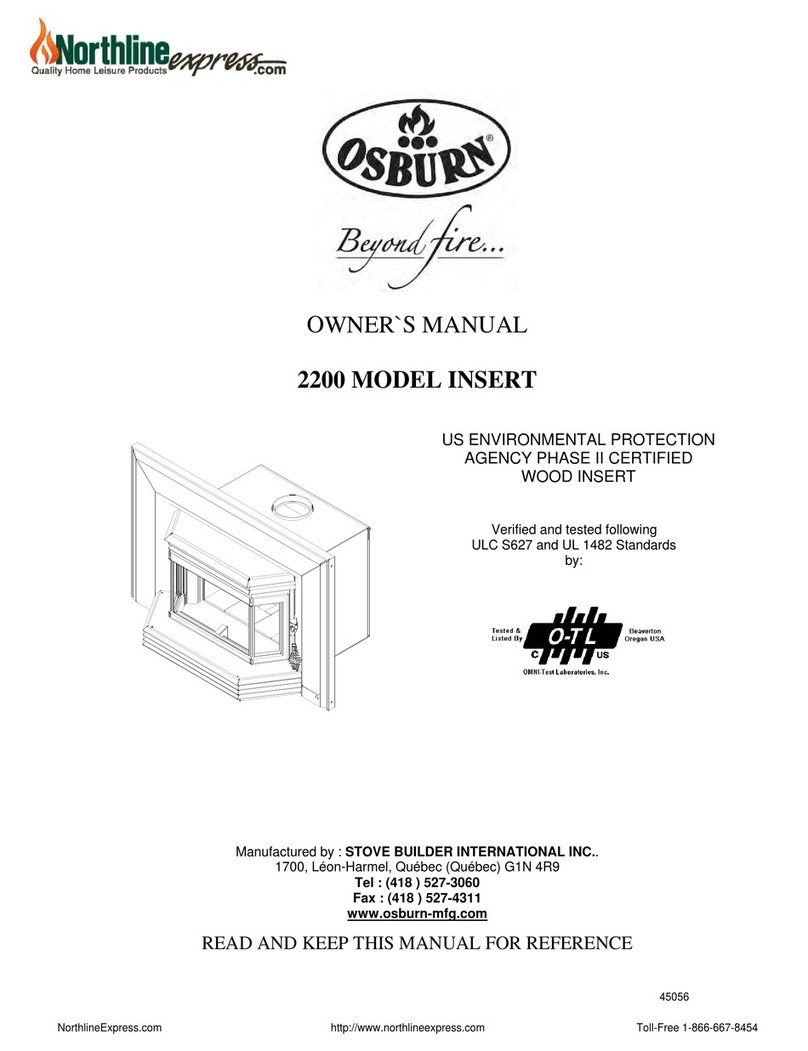
EXHAUSTO
SECTION 1: SMOKE - PROBLEMS & CAUSES
relatively small inlets, and therefore the draft must be
strong.
These are some typical performance problems:
n The chimney flue is too small.
A chimney may be severely restricted if the inner
diameter of the flue is too small. This situation often
occurswhenachimneyisre-lined,andtheflueopening
thereby is reduced.
In this situation, the velocity of the flue gases
reaches a point where the flow resistance is so sub-
stantial that the flow resistance exceeds the draft.
Aruleof thumb for maximumvelocityis1,800FPM
in the flue.
Itiscommonbeliefthattheactualareaofachimney
flue determines the capacity of the chimney. The
shape of the flue is also important when determining
the required area.
An 8"x12" flue has an area of 96 sq.in., while an 8"
round flue has an area of 50 sq.in., or roughly 50% of
the capacity of the 8"x12" flue.
However, the corners in a rectangular duct are
counter-productive and add to the resistance.
Analternativetojustcalculatingtheareaoftheflue
openingoftherectangularflue is to use the areaofthe
largest round flexible tube that can be inserted. (this is
meantasaguidelineandhasnothingtodowiththesize
liner that can be installed. In technical term this is
referred to as the "hydraulic diameter").
Refer to Appendix B, pg. 25: "Conversion of Rect-
angular Flues".
n The chimney flue is too large
Whileincreasingfluesizeincreasesthe capacityof
a chimney by reducing the flow resistance, it will
decrease draft. Gases move more slowly in a large
flue, and will maintain a lower average temperature
since they have more time to cool.
Extremecoolingcanoffset the gain in capacityand
could even lead to a net decrease in draft.
This phenomena is typical where a stove or fire-
place insert is connected to a chimney that was origi-
nallysizedand designed for anopenfireplace.Closed
heaters require smaller flues.
n The chimney is too short.
There is a better draft in a tall chimney than in a
Chimney Performance
The most important part of a woodburning system
is the chimney, and to work properly it must safely
exhaust the product of combustion and at the same
time draw enough oxygen into the appliance to main-
tain combustion.
Chimneys operate on the simple principle that
warmairrisesbecauseithasalowerdensity than cold
air. Warmer flue gases in the chimney create a pres-
suredifferencecalleddraftandtherising gases create
a partial vacuum at the bottom of the chimney and at
the appliance.
What's known as "draft problems" are actually
chimneyperformanceproblemsandareseldomcaused
by inadequate draft. They are more often caused by
poor design and operational problems caused by the
chimney itself.
There are two major factors to consider when
working with chimneys: draft and flue gas volume (or
flow). Draft is the force which causes the gases to be
exhausted.Thefluegasvolumeistheamountofgases
which pass through the system as a result of the draft.
Thesizingofachimneyshouldbebasedontheflow
requirement,asanychimneysizehasacertaincapac-
ity in regards to the appliance it is serving.
Two major factors influence the chimney capacity:
draftandflowresistance.Flowresistance isaresultof
friction, and always exists between the moving gases
and the flue through which they flow. Even straight
walls represent flow resistance, but of course bends,
turns, shape of the flue etc. are more restrictive.
For a system to work properly, the draft MUST
exceed the flow resistance. Otherwise the flow is
reversed in the system.
Chimney Performance Problems
Theprinciples forflowand draft applyto all heating
appliances,buttherearesomedifferencestobeaware
of. Open heaters (open fireplaces, BBQ's) require a
large chimney capacity, as they exhaust a relatively
large volume of flue gases, because of the speed at
which the combustion takes place. As a result, they
alsodrawplentyofroomair,whichlowerstheaverage
flue gas temperature, which lowers the average chim-
ney temperature, which again reduces the draft.
Closed heaters (stoves, fireplace inserts, ovens,
etc.)burnmoreslowly,andthusproducelessexhaust.
The flow of air for combustion is restricted by the
3
http://www.northlineexpress.com






































